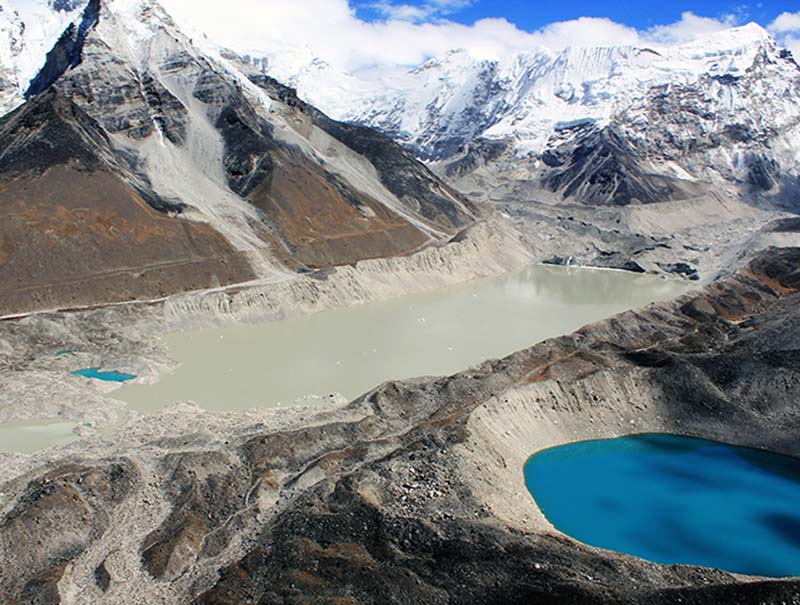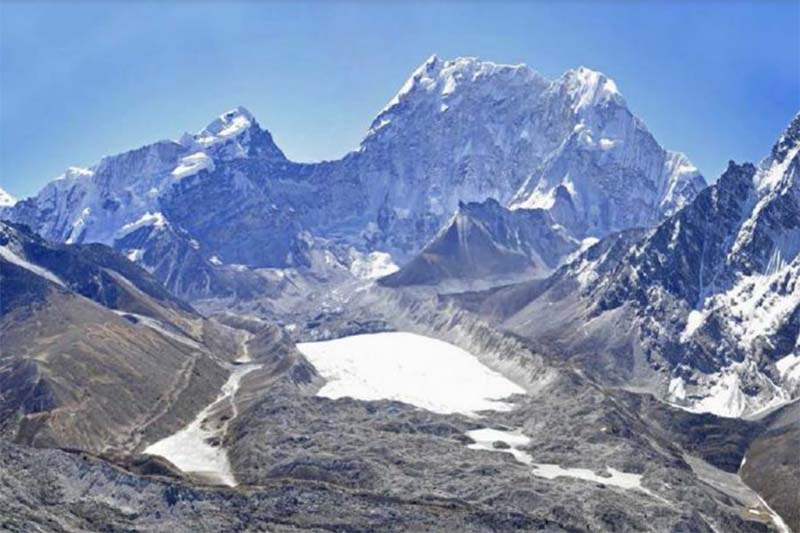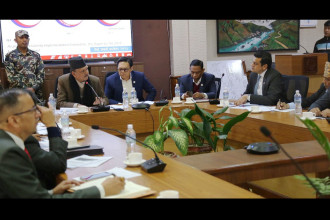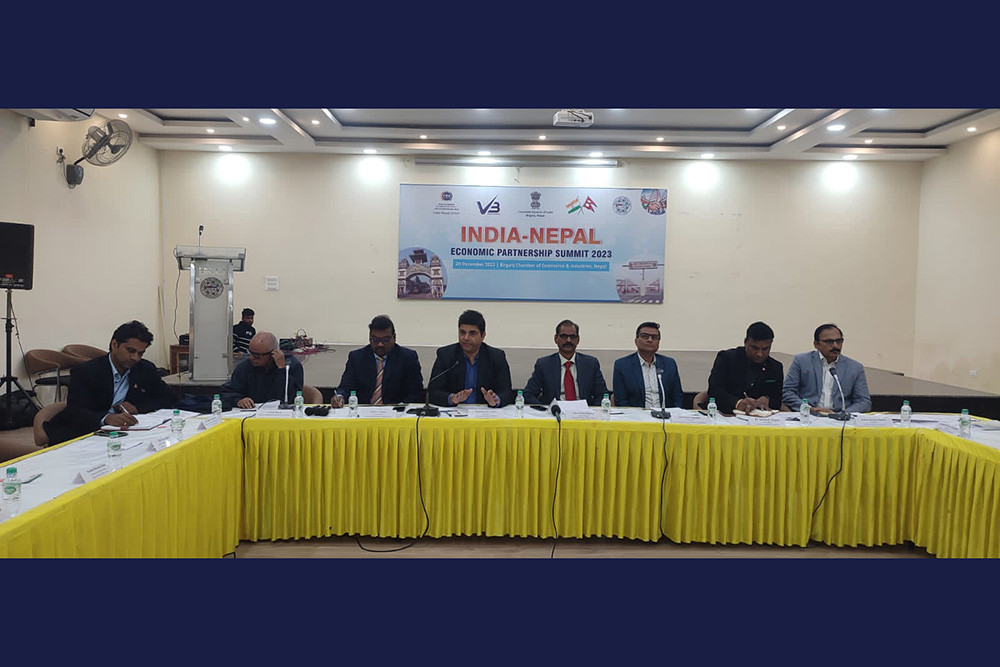
KATHMANDU: The glaciers in the Himalayan region have declined in area and volume, according to the climate change study report made public on Friday.
The study report conducted by Transparency International (TI) Nepal in collaboration with ICIMOD and other organisations was made public in the capital.
The study was carried out to look into the impact of climate change on water resources in Nepal's mountainous region and in the lower coastal region.
According to the report, high variation in temperature and precipitation was observed due to geographical conditions of the Himalayan region. The latest study has revealed the findings of an earlier study report that the area of glaciers in Nepal decreased by about 24% from 1977 to 2010. It is revealed that the height of the Imja and Lhotse glaciers in the Khumbu region of Nepal decreased from 1970 to 2007.
[gallery columns="1" link="file" size="full" ids="18086,18085"]
The risk of flooding caused by glacial bursting has also increased. In Koshi, Gandaki and Karnali watersheds, 47 potentially dangerous glacial lakes have been identified. Of these, 21 are in the high mountainous region of Nepal, 25 in Tibet and one in India. The study has also brought out the fact that 35 glaciers have burst in Nepal's mountain range so far.
[caption id="attachment_18084" align="alignnone" width="800"] Complete aerial view of source of Imja Glacier Lake and the natural outlet in 2009. Photo courtesy: ICIMOD via DHM Nepal[/caption]
Coordinator of the study task force, Mohan Bahadur Chand, said that the lake burst in the Kanchenjunga area in 1963 was confirmed by the local elders during the on-site study. However, there is no record of it and the issue was not even reported in the media.
Former environment ministry secretary Krishna Gyawali said that even though the environment council was formed under the chair of the prime minister to discuss such issues it was not meeting regularly due to its cumbersome structure.
Under Secretary at the Ministry of Forest and Environment, Arun Prakash Bhatta, said that the recent floods in Melamchi, avalanches in Manang and unseasonal rains in the far-western region was due to the impact of climate change. He said that the developed countries should also play a role in solving the problem of carbon emissions.
On the occasion, TI Nepal President Padmini Pradhanang, Vice President Budhinarayan Shrestha, General Secretary Mukunda Bahadur Pradhan, Ramesh Raj Pantal of the Central Department of Environmental Sciences, Tribhuvan University and others stressed the need for Nepal to start a detailed study on the impact of climate change using its own resources.
They also stressed the need to pay attention to the fact that the local levels are spending budget allocated for the study on climate change on development works, thereby depriving people of the information they need to be aware of the problem.
By RSS
READ ALSO:
Complete aerial view of source of Imja Glacier Lake and the natural outlet in 2009. Photo courtesy: ICIMOD via DHM Nepal[/caption]
Coordinator of the study task force, Mohan Bahadur Chand, said that the lake burst in the Kanchenjunga area in 1963 was confirmed by the local elders during the on-site study. However, there is no record of it and the issue was not even reported in the media.
Former environment ministry secretary Krishna Gyawali said that even though the environment council was formed under the chair of the prime minister to discuss such issues it was not meeting regularly due to its cumbersome structure.
Under Secretary at the Ministry of Forest and Environment, Arun Prakash Bhatta, said that the recent floods in Melamchi, avalanches in Manang and unseasonal rains in the far-western region was due to the impact of climate change. He said that the developed countries should also play a role in solving the problem of carbon emissions.
On the occasion, TI Nepal President Padmini Pradhanang, Vice President Budhinarayan Shrestha, General Secretary Mukunda Bahadur Pradhan, Ramesh Raj Pantal of the Central Department of Environmental Sciences, Tribhuvan University and others stressed the need for Nepal to start a detailed study on the impact of climate change using its own resources.
They also stressed the need to pay attention to the fact that the local levels are spending budget allocated for the study on climate change on development works, thereby depriving people of the information they need to be aware of the problem.
By RSS
READ ALSO:
 Complete aerial view of source of Imja Glacier Lake and the natural outlet in 2009. Photo courtesy: ICIMOD via DHM Nepal[/caption]
Coordinator of the study task force, Mohan Bahadur Chand, said that the lake burst in the Kanchenjunga area in 1963 was confirmed by the local elders during the on-site study. However, there is no record of it and the issue was not even reported in the media.
Former environment ministry secretary Krishna Gyawali said that even though the environment council was formed under the chair of the prime minister to discuss such issues it was not meeting regularly due to its cumbersome structure.
Under Secretary at the Ministry of Forest and Environment, Arun Prakash Bhatta, said that the recent floods in Melamchi, avalanches in Manang and unseasonal rains in the far-western region was due to the impact of climate change. He said that the developed countries should also play a role in solving the problem of carbon emissions.
On the occasion, TI Nepal President Padmini Pradhanang, Vice President Budhinarayan Shrestha, General Secretary Mukunda Bahadur Pradhan, Ramesh Raj Pantal of the Central Department of Environmental Sciences, Tribhuvan University and others stressed the need for Nepal to start a detailed study on the impact of climate change using its own resources.
They also stressed the need to pay attention to the fact that the local levels are spending budget allocated for the study on climate change on development works, thereby depriving people of the information they need to be aware of the problem.
By RSS
READ ALSO:
Complete aerial view of source of Imja Glacier Lake and the natural outlet in 2009. Photo courtesy: ICIMOD via DHM Nepal[/caption]
Coordinator of the study task force, Mohan Bahadur Chand, said that the lake burst in the Kanchenjunga area in 1963 was confirmed by the local elders during the on-site study. However, there is no record of it and the issue was not even reported in the media.
Former environment ministry secretary Krishna Gyawali said that even though the environment council was formed under the chair of the prime minister to discuss such issues it was not meeting regularly due to its cumbersome structure.
Under Secretary at the Ministry of Forest and Environment, Arun Prakash Bhatta, said that the recent floods in Melamchi, avalanches in Manang and unseasonal rains in the far-western region was due to the impact of climate change. He said that the developed countries should also play a role in solving the problem of carbon emissions.
On the occasion, TI Nepal President Padmini Pradhanang, Vice President Budhinarayan Shrestha, General Secretary Mukunda Bahadur Pradhan, Ramesh Raj Pantal of the Central Department of Environmental Sciences, Tribhuvan University and others stressed the need for Nepal to start a detailed study on the impact of climate change using its own resources.
They also stressed the need to pay attention to the fact that the local levels are spending budget allocated for the study on climate change on development works, thereby depriving people of the information they need to be aware of the problem.
By RSS
READ ALSO:
- Govt focusing on promotion of clean energy to cope with climate change: PM Deuba
- Camera Sika, Road to COP26 climate change films by young people awarded
- South Asia’s handling of Covid 19 crisis portends a dire situation for the region’s response to the climate change crisis, say SAWTEE experts
- Climate Crisis on Back Burner
- UNDP, Imja final report
Published Date: January 1, 2022, 12:00 am
Post Comment
E-Magazine

Click Here To Read Full Issue
RELATED B360 National




